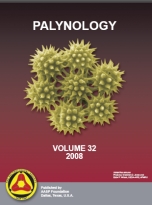The palynology of the Upper Cretaceous to Neogene non-marine succession in the Melut Basin, southeast Sudan was investigated. The palynomorphs are overwhelmingly of terrestrial origin, but rare brackish water dinoflagellate cysts and scolecodonts were encountered from the Lower Miocene and Oligocene-Miocene. Mangrove pollen, which is common in coeval West African coastal basins, is rare and inconsistent. Examples are Spinizonocolpites (Nypa) from the Campanian-Maastrichtian to Eocene and Rhizophoraceae (Zonocostites ramonae) from the Neogene. Based on the stratigraphic distribution of selected pollen and spores from four exploration wells, eight informal palynozones from the Campanian to the Neogene are proposed. The zones, in stratigraphically ascending order, are as follows: Assemblage Zone I, Campanian (lower Melut Formation); Assemblage Zone II, Campanian-Maastrichtian (middle Melut Formation); Assemblage Zone III, Maastrichtian (upper Melut Formation); Assemblage Zone IV, Paleocene (Yale Formation); Assemblage Zone V, Eocene (upper Yale and Adar formations); Assemblage Zone VI, Oligocene-Early Miocene (Jimidi and lower Miadol formations); Assemblage Zone VII, Early Miocene (uppermost Miadol and lowermost Daga formations); and Assemblage Zone VIII, Late Miocene-Pliocene (Daga Formation). The ages are based on stratigraphic positions and a series of first downhole appearances of key species such as Foveotricolpites cf. giganteus (Zone I), Auriculiidites reticulatus (Zone II), Ariadnaesporites spinosus (Zone III), Periretisyncolpites giganteus (Zone IV), Retistephanocolpites williamsii (Zone V), Cricotriporites camerounensis (Zone VI), Perfotricolpites digitatus (Zone VII), and Peregrinipollis nigericus (Zone VIII).
Palynofacies investigations indicated differences between the Late Cretaceous and Paleogene-Neogene paleoenvironments of the sections studied. The coexistence of structured organic palynodebris with pteridophyte spores, including those of water ferns (Ariadnaesporites), in the Upper Cretaceous strata suggests swampy conditions within a predominantly fluvial setting. The frequent occurrence of Palmae pollen indicates warm, humid conditions during the Late Cretaceous, although seasonal or hinterland aridity is suggested because of the occurrence of ephedroid pollen. Late Paleogene and Neogene assemblages are characterized by amorphous organic matter, fern spores, freshwater algae, and Gramineae pollen. Deposition in lacustrine habitats under warm, humid conditions is inferred. The occurrence of Gramineae pollen, mainly in the Neogene, indicates the development of grassy areas in a seasonally dry climate. A short marine incursion may have taken place during the Oligocene-Miocene, due to the rare occurrence of brackish water dinoflagellate cysts and scolecodonts.





